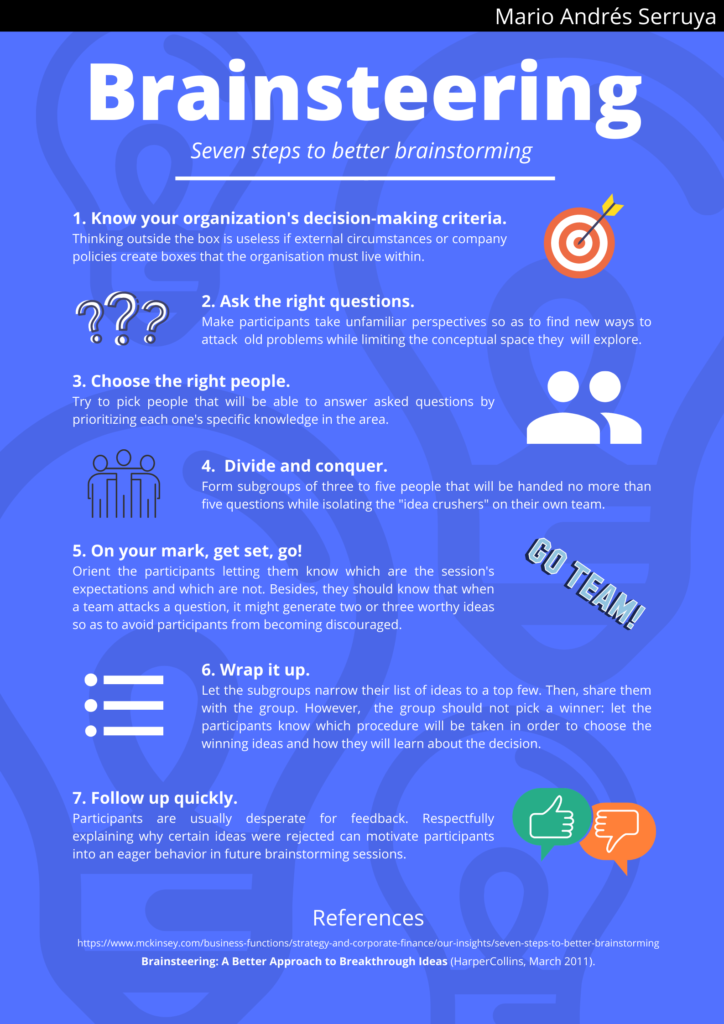Brainsteering: Seven Steps to Better Brainstorming
Successful companies are based on successful ideas. Yet as simple as it seems to state, most companies worldwide suffer the struggle of coming up with new and innovative ideas.
Trying to tackle the challenge, many attempt to reach ground breaking ideas through traditional brainstorming sessions. The scenario is already well-known: a group of people is gathered in the same room where a moderator (often an outsider to the company) starts by talking about “getting creative” and “thinking outside the box”. The final result is also known to those that have already suffered the pain of going through one of these sessions: boredom takes over the whole room where just a few bunch of people come up with arguably good ideas.
Brainstorming may eventually result in fortunate ideas. However, the technique is not able to exploit the large amount of talent that the sessions gather in the same room. Consequently, Brainsteering is introduced as a new approach to take over the potential of the concerned scenario.
Brainsteering is defined as a variation of traditional brainstorming which, through wider preparation and a well-specified set of steps, is able to reach worthwhile results.
So as to carry out a successful brainsteering session, the following steps must be conducted:
1. Know your organization’s decision making criteria
Within any brainstorming session, “thinking outside the box” is usually considered as the main objective. However, a good amount of successful ideas end up being disregarded as they are situated beyond the scope of what the organization will ever be willing to consider. Consequently, focusing on the aforementioned objective may result useless if external circumstances or company policies create boxes that the organization must live within. Therefore, the organization’s context must be considered within any brainsteering session so as to make the most out of the participant’s invested effort.
2. Ask the right questions
Addressed questions conform another matter of concern. Providing unspecific challenges eases the appearance of shallow solutions addressing a wider spectrum than the one desired. Therefore, the right questions must be performed aiming tomake participants take unfamiliar perspectives so as to find new ways to attack old problems while limiting the conceptual space they will explore.
3. Choose the right people
Traditional brainstorming sessions prioritize participants with higher ranks within the organization rather than choosing them by their specific knowledge. Considering the concerned viewpoint, members of any brainsteering session must be picked taking into account the firsthand knowledge that each one has in relation to the addressed topic. It may be easier to say than to achieve, but the whole point of the ongoing step could be summarized by the statement “pick people that can answer the questions that you are asking”.
4. Divide and conquer
Forming subgroups of three to five people focusing on a single question for no longer than 30 minutes results more productive than holding a single discussion about a unique topic between the whole group. Following the aforementioned strategy, subgroups could handle a bigger number of challenges (5 questions at most) improving the session’s effectiveness. When performing the subgroups division, it is important to isolate “idea crushers” within the same subgroup. These come in three flavors: bosses, “big mouths” and subject matter experts; and joining them within the same bounds could even benefit the workshop.
5. On your mark, get set, go!
Orient the participants letting them know which are the session’s expectations and which are not. Besides, they should know that when a team attacks a question, it might generate two or three worthy ideas so as to avoid participants from becoming discouraged.
6. Wrap it up
Let the subgroups narrow their list of ideas to a top few. Then, share them with the group. However, the group should not pick a winner: let the participants know which procedure will be taken in order to choose the winning ideas and how they will learn about the decision.
7. Follow up quickly
Participants are usually desperate for feedback. Respectfully explaining why certain ideas were rejected can motivate participants into an eager behavior in future brainstorming sessions.
References

